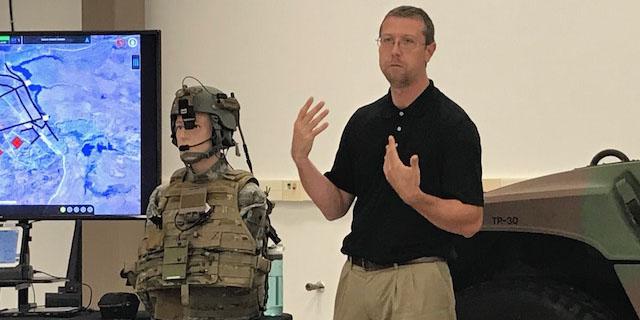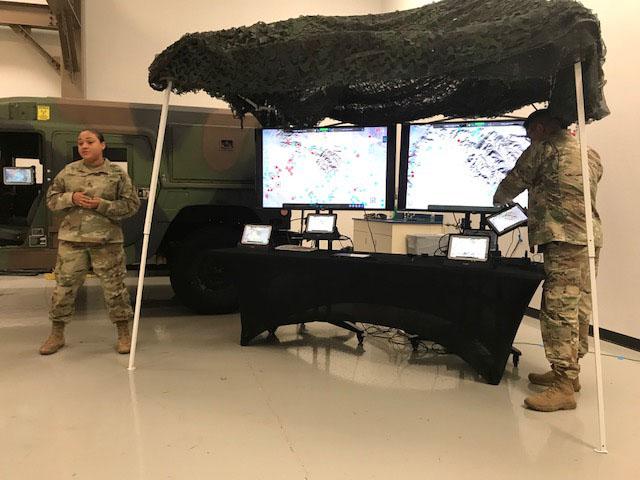New Software Provides Improved C2 Capabilities
The U.S. Army’s Communications-Electronics Research, Development and Engineering Center, known as CERDEC, has unveiled new mission command software that provides improved real-time command and control capabilities.
CERDEC, a part of the Army’s Research, Development and Engineering Command, has been developing capabilities under its Expeditionary Mission Command (EMC) Science and Technology Objective (STO). This year, it is rolling out 15 new capabilities, including software advances such as the Tactical Computing Environment (TCE) and the Single, Multimodal, Android Service for Human-Computer Interaction software known as SMASH.
Developed over the last four years, the TCE is a user interface that operates across the command post, mounted and dismounted network environments, CERDEC officials explained at its recent media day. It can be used in Android, Windows and Linux environments, they said.
“We concentrated on the cross-platform user experience, collaborative data experience across those platforms, as well as other ways to use a computer other than with a keyboard or mouse,” said Cyndi Carpenter, chief of the Data Engineering branch, Mission Command Capabilities Division, EMC, CERDEC.
The TCE is meant to “untether” commanders and staff from the command post while providing a real-time collaborative, shared understanding of the common operating picture (COP), according to CERDEC. The software provides mission command capabilities in disconnected, interrupted and low-bandwidth environments, CERDEC stated. The software platform operates over the Soldier Radio Waveform, the Ethernet, Wi-Fi and 4G LTE networks. The TCE pulls in numerous Army data feeds as well as allowing for “rapid integration of new data sources,” according to CERDEC.
Observer Coach/Trainers (OC/Ts) at the National Training Center at Ft. Irwin, California, already are using the TCE during troop training rotations as part of their exercise control COP, said Sgt. 1st Class Sheena Ferrell, USA, OC/T Cobra 3A, National Training Center, Fort Irwin.
The software includes a camera feature, free drawing capabilities, a chat feature, direct messaging, notepad, file sharing, and grouping, tracking and following capabilities, Sgt. Ferrell noted. The features enhance communications and information sharing between leadership and units in the field by allowing users to show others information of interest, virtually, in real time. For example, if a unit is able to see certain obstacles or outposts on the battlefield, they can identify that information on their own mission command system, which is replicated to the TCE.
“If I’m on the move, I'm going to see it in my vehicle, so [it gives] better eyes on what is happening,” she said.
The notepad feature allows communications to be written and saved virtually, important for soldiers on the move. “With a display system mounted in a vehicle, sometimes we have notes that we have to take down, we have a radio system in there and we are getting told grids and things and it is not always convenient to have a pen,” Sgt. Ferrell said.
The TCE has transitioned from CERDEC to the Program Executive Office of Simulation, Training and Instrumentation (PEO STRI). Work on the TCE software will be completed this year, Carpenter said.
Meanwhile, engineers at CERDEC have been developing advanced human computer interaction (HCI) software, shared Dan Lenhardt, lead engineer at the center. The team examines robotics systems, unmanned teaming and display technologies, and how users interact with these technologies,. “Most of our focus is on mounted and dismounted capabilities for units to use on the move,” he said.
These soldiers are often in environments where a traditional keyboard or mouse is not practical, CERDEC stated.
The new SMASH platform offers a voice activated command capability, which can tie into the TCE, as well as other systems, Lenhardt stated. As an HCI platform, SMASH software gives third-party developers the ability to integrate advanced technologies into DOD systems in a simpler, standardized way. “It means that developers do not need to be masters in speech recognition,” he said. “They can pull in these technologies into their software applications that they are developing in a much easier way.”
CERDEC engineers have incorporated the system into helmet-mounted displays as well as heads-up devices for hands-free interaction and improved communication and situational awareness, Lenhardt said. SMASH allows soldiers to fully control the technologies using voice commands. SMASH can operate in a number of noise environments, including vehicular noise—inside of a HMMWV—as well as aircraft noise, Lenhardt indicated.
The center is integrating the SMASH capability into other Army technologies, such as Night Vision and NETT Warrior. The engineers also are working to integrate SMASH into military medical applications, including tactical capabilities for Army medics. For medics, having the ability to engage in voice reporting using the SMASH system when they are moving patients and trying to keep track of medical information on how the patients were triaged and treated will make sure “that the information goes with the patient,” Lenhardt stated.
Soldiers who have field tested SMASH have given key feedback, Lenhardt continued. While the soldiers like being able to employ a technology through voice commands, the voice command terms need to reflect their specific unit’s standard operating procedures, he said. As such, CERDEC added a capability known as HULC, the HCI User Linguistic Customizer, which “allows people to update voice commands dynamically on the fly,” Lenhardt indicated.
SMASH is transitioning from CERDEC to the Program Manager, Mission Command, for integration with their friendly force tracking logistics system known as the Joint Battle Command Platform (JBC-P) system, CERDEC reported.






Comments